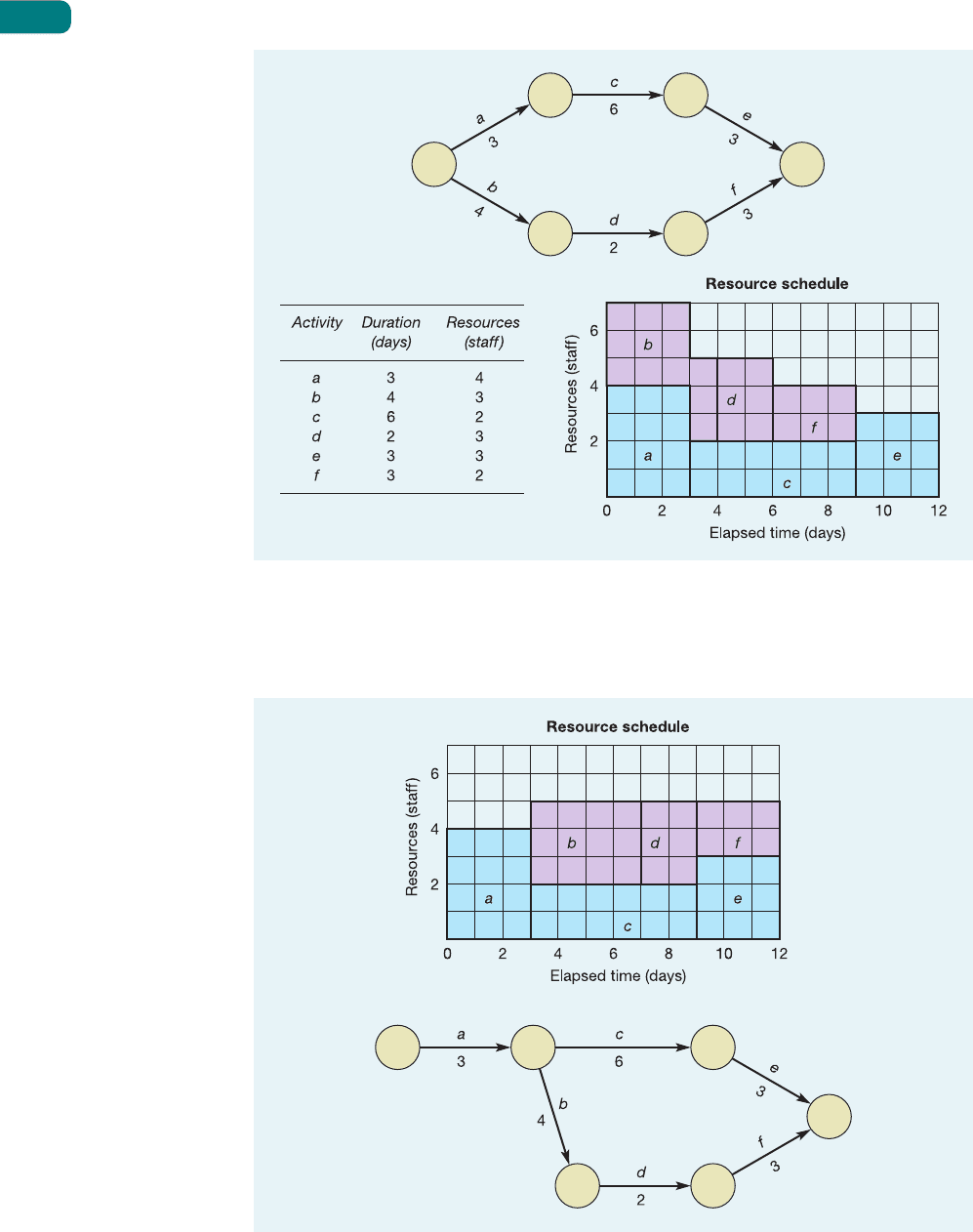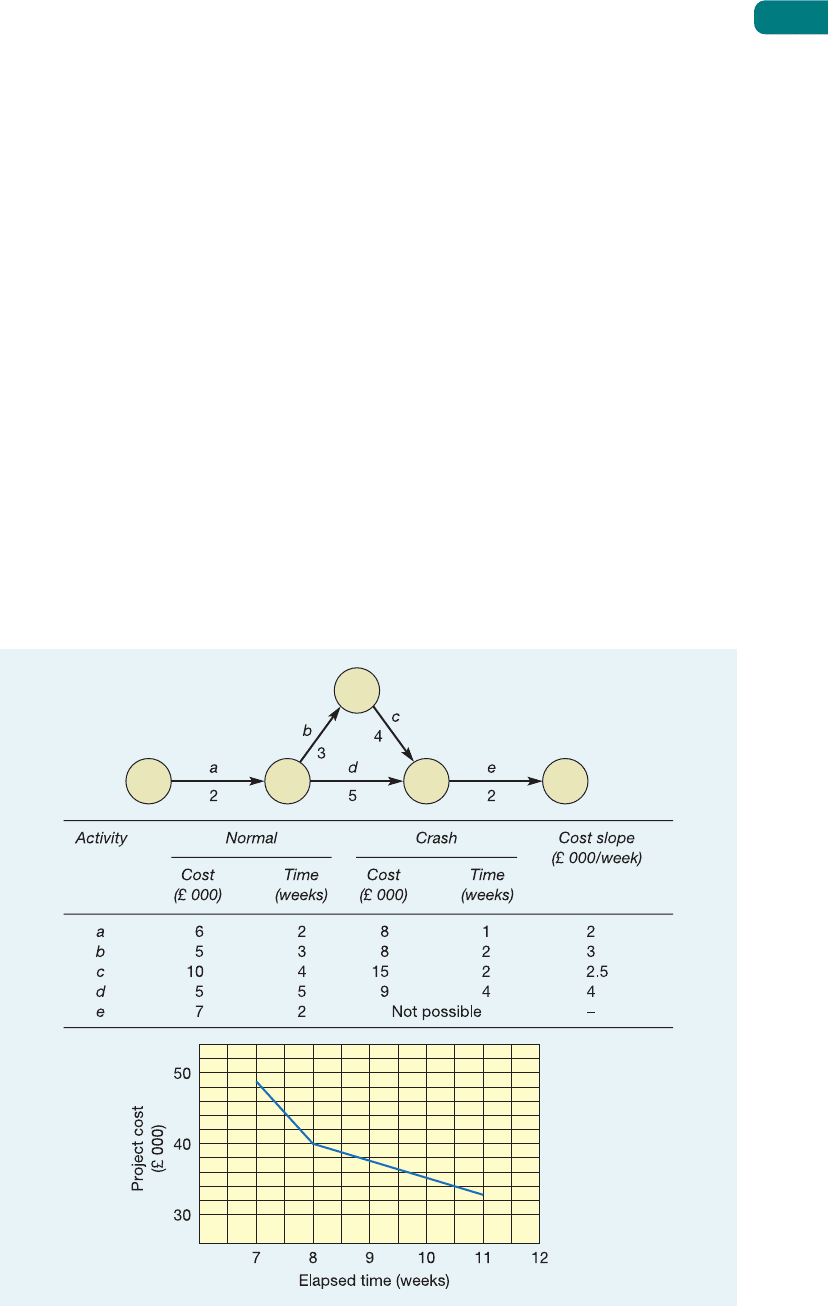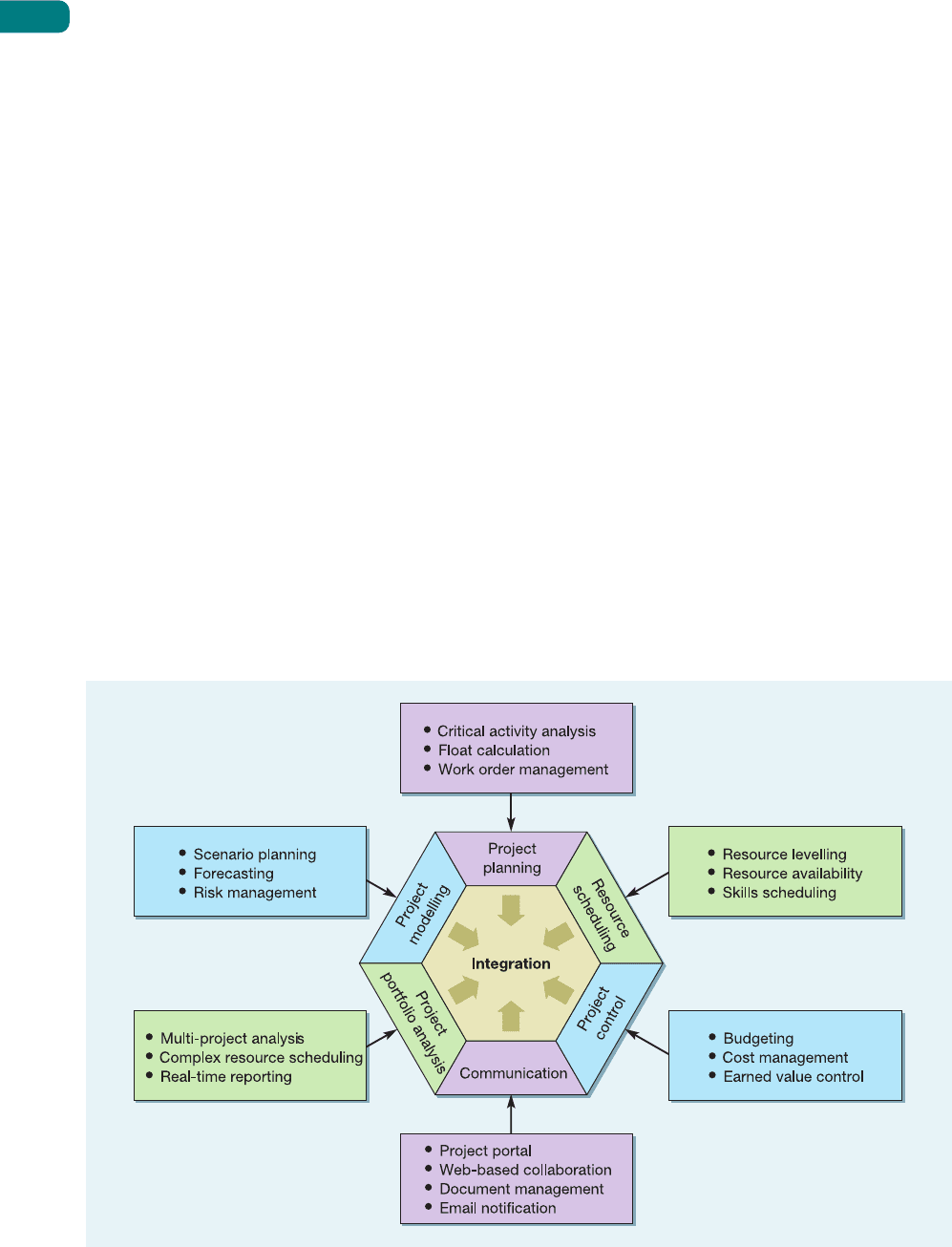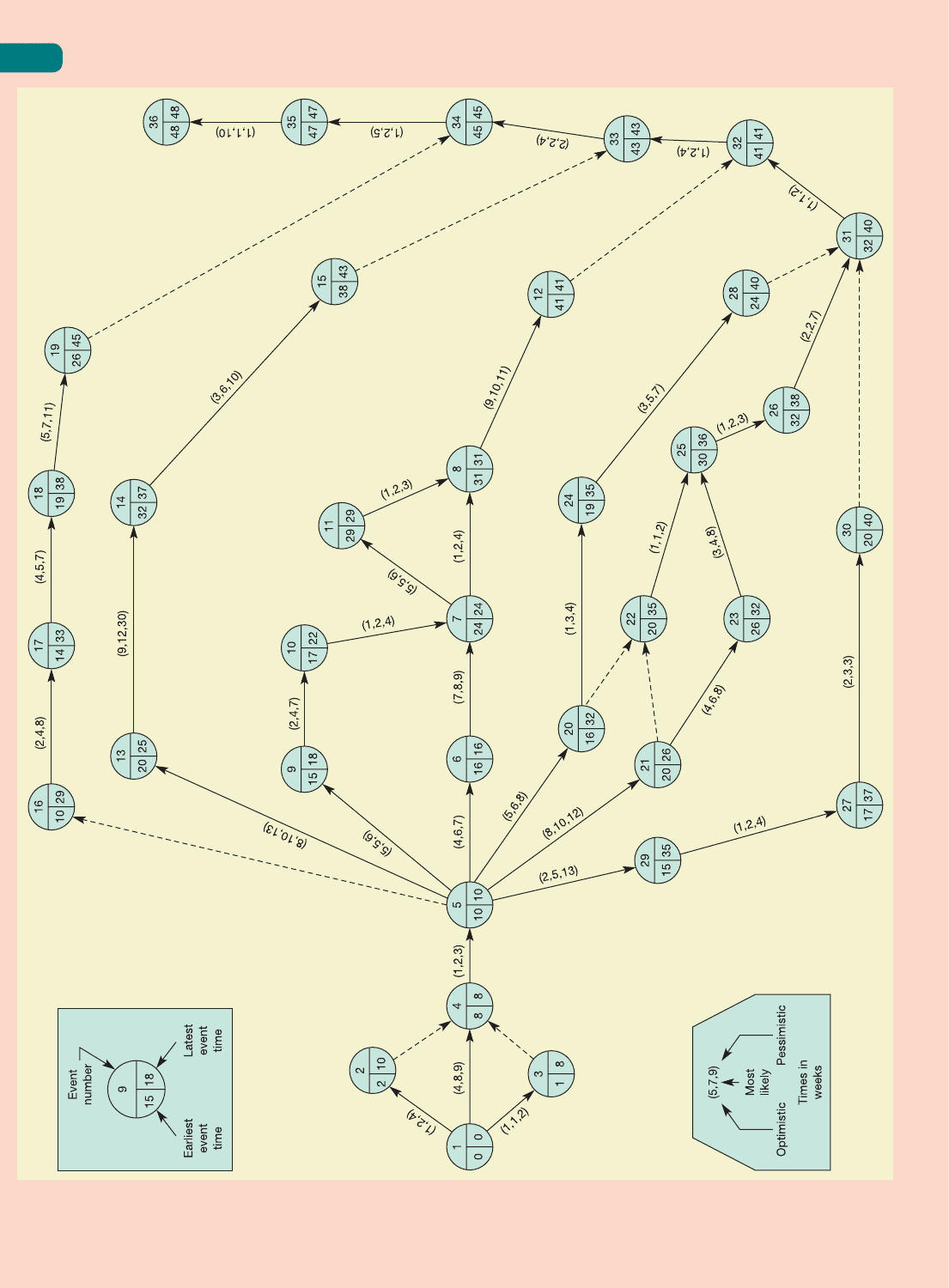Nigel S., Chambers S., Johnson R. Operations Management
Подождите немного. Документ загружается.


Part Three Planning and control
484
Figure 16.22 Resource profile of a network assuming that all activities are started as soon as
possible
Figure 16.23 Resource profile of a network with non-critical activities delayed to fit
resource constraints; in this case this effectively changes the network logic to make all
activities critical
M16_SLAC0460_06_SE_C16.QXD 10/20/09 15:22 Page 484

Crashing networks
Crashing networks is the process of reducing time spans on critical path activities so that the
project is completed in less time. Usually, crashing activities incurs extra cost. This can be as
a result of:
● overtime working;
● additional resources, such as manpower;
● subcontracting.
Figure 16.24 shows an example of crashing a simple network. For each activity the dura-
tion and normal cost are specified, together with the (reduced) duration and (increased)
cost of crashing them. Not all activities are capable of being crashed; here activity e cannot
be crashed. The critical path is the sequence of activities a, b, c, e. If the total project time is
to be reduced, one of the activities on the critical path must be crashed. In order to decide
which activity to crash, the ‘cost slope’ of each is calculated. This is the cost per time period
of reducing durations. The most cost-effective way of shortening the whole project then is
to crash the activity on the critical path which has the lowest cost slope. This is activity a, the
crashing of which will cost an extra £2,000 and will shorten the project by one week. After
this, activity c can be crashed, saving a further two weeks and costing an extra £5,000. At this
point all the activities have become critical and further time savings can only be achieved by
crashing two activities in parallel. The shape of the time–cost curve in Figure 16.24 is entirely
typical. Initial savings come relatively inexpensively if the activities with the lowest cost slope
are chosen. Later in the crashing sequence the more expensive activities need to be crashed
and eventually two or more paths become jointly critical. Inevitably by that point, savings in
time can only come from crashing two or more activities on parallel paths.
Crashing
Chapter 16 Project planning and control
485
Figure 16.24 Crashing activities to shorten project time becomes progressively more expensive
M16_SLAC0460_06_SE_C16.QXD 10/20/09 15:22 Page 485

Computer-assisted project management
For many years, since the emergence of computer-based modelling, increasingly sophisticated
software for project planning and control has become available. The rather tedious computa-
tion necessary in network planning can relatively easily be performed by project planning
models. All they need are the basic relationships between activities together with timing
and resource requirements for each activity. Earliest and latest event times, float and other
characteristics of a network can be presented, often in the form of a Gantt chart. More signi-
ficantly, the speed of computation allows for frequent updates to project plans. Similarly, if
updated information is both accurate and frequent, such a computer-based system can also
provide effective project control data. More recently, the potential for using computer-based
project management systems for communication within large and complex projects has been
developed in so-called Enterprise Project Management (EPM) systems.
Figure 16.25 illustrates just some of the elements that are integrated within EPM systems.
Most of these activities have been treated in this chapter. Project planning involves critical path
analysis and scheduling, an understanding of float, and the sending of instructions on when
to start activities. Resource scheduling looks at the resource implications of planning decisions
and the way a project may have to be changed to accommodate resource constraints. Project
control includes simple budgeting and cost management together with more sophisticated
earned value control. However, EPM also includes other elements. Project modelling involves
the use of project planning methods to explore alternative approaches to a project, identify-
ing where failure might occur and exploring the changes to the project which may have to
be made under alternative future scenarios. Project portfolio analysis acknowledges that,
for many organizations, several projects have to be managed simultaneously. Usually these
share common resources. Therefore, not only delays in one activity within a project affect
other activities in that project, they may also have an impact on completely different projects
Part Three Planning and control
486
Figure 16.25 Some of the elements integrated in enterprise project management systems
Enterprise Project
Management
M16_SLAC0460_06_SE_C16.QXD 10/20/09 15:22 Page 486

which are relying on the same resource. Finally, integrated EPM systems can help to com-
municate, both within a project and to outside organizations which may be contributing
to the project. Much of this communication facility is web-based. Project portals can allow
all stakeholders to transact activities and gain a clear view of the current status of a project.
Automatic notification of significant milestones can be made by e-mail. At a very basic level,
the various documents that specify parts of the project can be stored in an online library.
Some people argue that it is this last element of communication capabilities that is the most
useful part of EPM systems.
Chapter 16 Project planning and control
487
Summary answers to key questions
Check and improve your understanding of this chapter using self assessment questions
and a personalised study plan, audio and video downloads, and an eBook – all at
www.myomlab.com.
➤ What is a project?
■ A project is a set of activities with a defined start point and a defined end state, which pursues
a defined goal and uses a defined set of resources.
■ All projects can be characterized by their degree of complexity and the inherent uncertainty in
the project.
■ Project management has five stages, four of which are relevant to project planning and control:
understanding the project environments, defining the project, planning the project, technical
execution of the project (not part of project planning and control) and project control.
➤ Why is it important to understand the environment in which a project
takes place?
■ It is important for two reasons. First, the environment influences the way a project is carried
out, often through stakeholder activity. Second, the nature of the environment in which a pro-
ject takes place is the main determinant of the uncertainty surrounding it.
➤ How are projects planned and controlled?
■ Projects can be defined in terms of their objectives (the end state which project manage-
ment is trying to achieve), scope (the exact range of the responsibilities taken on by project
management), and strategy (how project management is going to meet the project objectives).
➤ What is project planning and why is it important?
■ Project planning involves five stages.
– Identifying the activities within a project;
– Estimating times and resources for the activities;
– Identifying the relationship and dependencies between the activities;
– Identifying the schedule constraints;
– Fixing the schedule.
➔
M16_SLAC0460_06_SE_C16.QXD 10/20/09 15:22 Page 487

Part Three Planning and control
488
Introduction
Anuar Kamaruddin, COO of United Photonics Malaysia
(EPM), was conscious that the project in front of him was
one of the most important he had handled for many years.
The number and variety of the development projects under
way within the company had risen sharply in the last few
years, and although they had all seemed important at the
time, this one – the ‘Laz-skan’ project – clearly justified the
description given it by the President of United Photonics
Corporation, the US parent of UPM, ‘the make or break
opportunity to ensure the division’s long term position in
the global instrumentation industry’.
The United Photonics Group
United Photonics Corporation had been founded in the
1920s (as the Detroit Gauge Company), a general instru-
ment and gauge manufacturer for the engineering industry.
By expanding its range into optical instruments in the early
1930s, it eventually moved also into the manufacture of
Case study
United Photonics Malaysia Sdn Bhd
Source: Corbis/Eric K K Yu
■ Project planning is particularly important where complexity of the project is high. The inter-
relationship between activities, resources and times in most projects, especially complex ones,
is such that unless they are carefully planned, resources can become seriously overloaded at
times during the project.
➤ What techniques can be used for project planning?
■ Network planning and Gantt charts are the most common techniques. The former (using either
the activity-on-arrow or activity-on-node format) is particularly useful for assessing the total
duration of a project and the degree of flexibility or float of the individual activities within the
project. The most common method of network planning is called the critical path method (CPM).
■ The logic inherent in a network diagram can be changed by resource constraints.
■ Network planning models can also be used to assess the total cost of shortening a project
where individual activities are shortened.
➤ What is project control and how is it done?
■ The process of project control involves three sets of decisions: how to monitor the project
in order to check its progress, how to assess the performance of the project by comparing
monitored observations to the project plan, and how to intervene in the project in order to make
the changes which will bring it back to plan.
■ Enterprise Project Management systems can be used to integrate all the information needed
to plan and control projects.
M16_SLAC0460_06_SE_C16.QXD 10/20/09 15:22 Page 488

high-precision and speciality lenses, mainly for the photo-
graphic industry. Its reputation as a specialist lens manu-
facturer led to such a growth in sales that by 1969 the
optical side of the company accounted for about 60 per
cent of total business and it ranked as one of the top two
or three optics companies of its type in the world. Although
its reputation for skilled lens-making had not diminished
since then, the instrument side of the company had come
to dominate sales once again in the 1980s and 1990s.
UPM product range
UPM’s product range on the optical side included lenses
for inspection systems which were used mainly in the
manufacture of microchips. These lenses were sold both
to the inspection system manufacturers and to the chip
manufacturers themselves. They were very high-precision
lenses; however, most of the company’s optical products
were specialist photographic and cinema lenses. In addi-
tion about 15 per cent of the company’s optical work was
concerned with the development and manufacture of ‘one
or two off’ extremely high-precision lenses for defence
contracts, specialist scientific instrumentation, and other
optical companies. The Group’s instrument product range
consisted largely of electromechanical assemblies with an
increasing emphasis on software-based recording, display
and diagnostic abilities. This move towards more software-
based products had led the instrument side of the business
towards accepting some customized orders. The growth
of this part of the instrumentation had resulted in a special
development unit being set up: the Customer Services Unit
(CSU) which modified, customized or adapted products
for those customers who required an unusual application.
Often CSU’s work involved incorporating the company’s
products into larger systems for a customer.
In 1995 United Photonics Corporation had set up its
first non-North American facility just outside Kuala Lumpur
in Malaysia. United Photonics Malaysia Sdn Bhd (UPM)
had started by manufacturing subassemblies for Photonics
instrumentation products, but soon had developed into a
laboratory for the modification of United Photonics products
for customers throughout the Asian region. This part of the
Malaysian business was headed by T.S. Lim, a Malaysian
engineer who had taken his postgraduate qualifications at
Stanford and three years ago moved back to his native KL
to head up the Malaysian outpost of the CSU, reporting
directly to Bob Brierly, the Vice-President of Development,
who ran the main CSU in Detroit. Over the last three years,
T.S. Lim and his small team of engineers had gained quite
a reputation for innovative development. Bob Brierly was
delighted with their enthusiasm. ‘Those guys really do know
how to make things happen. They are giving us all a run for
our money.’
The Laz-skan project
The idea for Laz-skan had come out of a project which
T.S. Lim’s CSU had been involved with in 2004. At that
time the CSU had successfully installed a high-precision
Photonics lens into a character recognition system for a
large clearing bank. The enhanced capability which the lens
and software modifications had given had enabled the bank
to scan documents even when they were not correctly
aligned. This had led to CSU proposing the development
of a ‘vision metrology’ device that could optically scan a
product at some point in the manufacturing process, and
check the accuracy of up to twenty individual dimensions.
The geometry of the product to be scanned, the dimensions
to be gauged, and the tolerances to be allowed, could all
be programmed into the control logic of the device. The
T.S. Lim team were convinced that the idea could have
considerable potential. The proposal, which the CSU team
had called the Laz-skan project, was put forward to Bob
Brierly in August 2004. Brierly both saw the potential value
of the idea and was again impressed by the CSU team’s
enthusiasm. ‘To be frank, it was their evident enthusiasm
that influenced me as much as anything. Remember that the
Malaysian CSU had only been in existence for two years at
this time – they were a group of keen but relatively young
engineers. Yet their proposal was well thought out and, on
reflection, seemed to have considerable potential.’
In November 2004 Lim and his team were allocated
funds (outside the normal budget cycle) to investigate the
feasibility of the Laz-skan idea. Lim was given one further
engineer and a technician, and a three-month deadline
to report to the board. In this time he was expected to
overcome any fundamental technical problems, assess
the feasibility of successfully developing the concept into
a working prototype, and plan the development task that
would lead to the prototype stage.
The Lim investigation
T.S. Lim, even at the start of his investigation, had some firm
views as to the appropriate ‘architecture’ for the Laz-skan
project. By ‘architecture’ he meant the major elements of the
system, their functions, and how they related to each other.
The Laz-skan system architecture would consider five major
subsystems: the lens and lens mounting, the vision support
system, the display system, the control logic software, and
the documentation.
T.S. Lim’s first task, once the system’s overall architec-
ture was set, was to decide whether the various com-
ponents in the major subsystems would be developed
in-house, developed by outside specialist companies from
UPM’s specifications, or bought in as standard units and
if necessary modified in-house. Lim and his colleagues
made these decisions themselves, while recognizing that
a more consultative process might have been preferable.
‘I am fully aware that ideally we should have made more
use of the expertise within the company to decide how units
were to be developed. But within the time available we
just did not have the time to explain the product concept,
explain the choices, and wait for already busy people to come
up with a recommendation. Also there was the security
Chapter 16 Project planning and control
489
➔
M16_SLAC0460_06_SE_C16.QXD 10/20/09 15:22 Page 489

Part Three Planning and control
490
Figure 16.26
M16_SLAC0460_06_SE_C16.QXD 10/20/09 15:22 Page 490

system was complicated, there was no great uncertainty in
the individual activities, or therefore the schedule of com-
pletion. If more funds were allocated to their development,
some tasks might even be completed ahead of time.
3 The control software (events 20 to 26, 28)
The control software represented the most complex task,
and the most difficult to plan and estimate. In fact, the soft-
ware development unit had little experience of this type of
work but (partly in anticipation of this type of development)
had recently recruited a young software engineer with
some experience of the type of work which would be
needed for Laz-skan. He was confident that any technical
problems could be solved even though the system needs
were novel, but completion times would be difficult to pre-
dict with confidence.
aspect to think of. I’m sure our employees are to be trusted
but the more people who know about the project, the more
chance there is for leaks. Anyway, we did not see our deci-
sions as final. For example, if we decided that a component
was to be bought in and modified for the prototype build-
ing stage it does not mean that we can’t change our minds
and develop a better component in-house at a later stage.’
By February 2005, TS’s small team had satisfied themselves
that the system could be built to achieve their original tech-
nical performance targets. Their final task before reporting
to Brierly would be to devise a feasible development plan.
Planning the Laz-skan development
As a planning aid the team drew up a network diagram
for all the major activities within the project from its start
through to completion, when the project would be handed
over to Manufacturing Operations. This is shown in Fig-
ure 16.26 and the complete list of all events in the diagram
is shown in Table 16.4. The duration of all the activities in
the project were estimated either by T.S. Lim or (more often)
by him consulting a more experienced engineer back in
Detroit. While he was reasonably confident in the estimates,
he was keen to stress that they were just that – estimates.
Two draughting conventions on these networks need
explanation. The three figures in brackets by each activity
arrow represent the ‘optimistic’, ‘most likely’ and ‘pessimistic’
times (in weeks) respectively. The left-side figure in the event
circles indicates the earliest time the event could take place
and the figure in the right side of the circles indicates the
latest time the event could take place without delaying the
whole project. Dotted lines represent ‘dummy’ activities.
These are nominal activities which have no time associated
with them and are there either to maintain the logic of the
network or for draughting convenience.
1 The lens (events 5-13-14-15)
The lens was particularly critical since the shape was com-
plex and precision was vital if the system was to perform
up to its intended design specification. T.S. Lim was relying
heavily upon the skill of the Group’s expert optics group in
Pittsburg to produce the lens to the required high tolerance.
Since what in effect was a trial and error approach was
involved in their manufacture, the exact time to manufac-
ture would be uncertain. T.S. Lim realized this.
‘The lens is going to be a real problem. We just don’t
know how easy it will be to make the particular geo-
metry and precision we need. The optics people won’t
commit themselves even though they are regarded as
some of the best optics technicians in the world. It is a
relief that lens development is not amongst the “critical
path” activities.’
2 Vision support system (events 6-7-8-12, 9-5, 11)
The vision support system included many components which
were commercially available, but considerable engineer-
ing effort would be required to modify them. Although the
development design and resting of the vision support
Chapter 16 Project planning and control
491
Table 16.4 Event listing for the Laz-skan project
Event number Event description
1 Start systems engineering
2 Complete interface transient tests
3 Complete compatibility testing
4 Complete overall architecture block and
simulation
5 Complete costing and purchasing tender
planning
6 End alignment system design
7 Receive S/T/G, start synch mods
8 Receive Triscan/G, start synch mods
9 Complete B/A mods
10 Complete S/T/G mods
11 Complete Triscan/G mods
12 Start laser subsystem compatibility tests
13 Complete optic design and specification,
start lens manufacture
14 Complete lens manufacture, start lens
housing S/A
15 Lens S/A complete, start tests
16 Start technical specifications
17 Start help routine design
18 Update engineering mods
19 Complete doc sequence
20 Start vision routines
21 Start interface (tmsic) tests
22 Start system integration compatibility
routines
23 Coordinate trinsic tests
24 End interface development
25 Complete alignment integration routine
26 Final alignment integration data
consolidation
27 Start interface (tmnsic) programming
28 Complete alignment system routines
29 Start tmnsic comparator routines
30 Complete (interface) trinsic coding
31 Begin all logic system tests
32 Start cycle tests
33 Lens S/A complete
34 Start assembly of total system
35 Complete total system assembly
36 Complete final tests and dispatch
➔
M16_SLAC0460_06_SE_C16.QXD 10/20/09 15:22 Page 491

4 Documentation (events 5-16-17-18-19)
A relatively simple subsystem, ‘documentation’ included
specifying and writing the technical manuals, maintenance
routines, online diagnostics, and ‘help desk’ information. It
was a relatively predictable activity, part of which was sub-
contracted to technical writers and translation companies
in Kuala Lumpur.
5 Display system (events 29-27-30)
The simplest of the subsystems to plan, the display system,
would need to be manufactured entirely out of the com-
pany and tested and calibrated on receipt.
Market prospects
In parallel with T.S. Lim’s technical investigation, Sales and
Marketing had been asked to estimate the market potential
of Laz-skan. In a very short time, the Laz-skan project had
aroused considerable enthusiasm within the function, to the
extent that Halim Ramli, the Asian Marketing Vice President,
had taken personal charge of the market study. The major
conclusions from this investigation were:
(a) The global market for Laz-skan type systems was
unlikely to be less than 50 systems per year in 2008,
climbing to more than 200 per year by 2012.
(b) The volume of the market in financial terms was more
difficult to predict, but each system sold was likely to
represent around US$300,000 of turnover.
(c) Some customization of the system would be needed
for most customers. This would mean greater emphasis
on commissioning and post-installation service than
was necessary for UPM’s existing products.
(d) Timing the launch of Laz-skan would be important.
Two ‘windows of opportunity’ were critical. The first
and most important was the major world trade show in
Geneva in April 2006. This show, held every two years,
was the most prominent show-case for new pro-
ducts such as Laz-skan. The second related to the
development cycles of the original equipment manu-
facturers who would be the major customers for
Laz-skan. Critical decisions would be taken in the fall
of 2006. If Laz-skan was to be incorporated into these
companies’ products it would have to be available
from October 2006.
The Laz-skan go ahead
At the end of February 2005 UPM considered both the
Lim and Ramli reports. In addition estimates of Laz-skan’s
manufacturing costs had been sought from George
Hudson, the head of Instrument Development. His estimates
indicated that Laz-skan’s operating contribution would be
far higher than the company’s existing products. The board
approved the immediate commencement of the Laz-skan
development through to prototype stage, with an initial
development budget of US$4.5 m. The objective of the
project was to, ‘build three prototype Laz-skan systems to
be “up and running” for April 2006’.
The decision to go ahead was unanimous. Exactly how
the project was to be managed provoked far more discus-
sion. The Laz-skan project posed several problems. First,
engineers had little experience of working on such a major
project. Second, the crucial deadline for the first batch of
prototypes meant that some activities might have to be
been accelerated, an expensive process that would need
careful judgement. A very brief investigation into which
activities could be accelerated had identified those where
acceleration definitely would be possible and the likely
cost of acceleration (Table 16.5). Finally, no one could agree
either whether there should be a single project leader,
which function he or she should come from, or how senior
the project leader should be. Anuar Kamaruddin knew that
these decisions could affect the success of the project,
and possibly the company, for years to come.
Questions
1 Who do you think should manage the Laz-skan
Development Project?
2 What are the major dangers and difficulties that will be
faced by the development team as they manage the
project towards its completion?
3 What can they do about these dangers and difficulties?
Part Three Planning and control
492
Table 16.5 Acceleration opportunities for Laz-skan
Activity Acceleration Likely maximum Normal most
cost activity time, likely time
(US$/week) with acceleration (weeks)
(weeks)
5–6 23,400 3 6
5–9 10,500 2 5
5–13 25,000 8 10
20–24 5,000 2 3
24–28 11,700 3 5
33–34 19,500 1 2
M16_SLAC0460_06_SE_C16.QXD 10/20/09 15:22 Page 492

Chapter 16 Project planning and control
493
These problems and applications will help to improve your analysis of operations. You
can find more practice problems as well as worked examples and guided solutions on
MyOMLab at
www.myomlab.com.
The activities, their durations and precedences for designing, writing and installing a bespoke computer
database are shown in Table 16.6. Draw a Gantt chart and a network diagram for the project and calculate the
fastest time in which the operation might be completed.
A business is launching a new product. The launch will require a number of related activities as follows – hire
a sales manager (5 weeks), require the sales manager to recruit sales people (4 weeks), train the sales people
(7 weeks), select an advertising agency (2 weeks), plan an advertising campaign with the agency (4 weeks),
conduct the advertising campaign (10 weeks), design the packaging of the product (4 weeks), set up packing
operation (12 weeks), pack enough products for the launch stock (8 weeks), order the launch quantity of
products from the manufacturer (13 weeks), select distributors for the product (9 weeks), take initial orders from
the distributors (3 weeks), dispatch the initial orders to the distributors (2 weeks). (a) What is the earliest time
that the new product can be introduced to the market? (b) If the company hire trained salesmen who do not
need further training, could the product be introduced 7 weeks earlier? (c) How long could one delay selecting
the advertising agency?
In the example above, if the sales manager cannot be hired for 3 weeks, how will that affect the total project?
In the previous example, if the whole project launch operation is to be completed as rapidly as possible, what
activities must have been completed by the end of week 16?
Identify a project of which you have been part (for example moving apartments, a holiday, dramatic production,
revision for an examination, etc.). (a) Who were the stakeholders in this project? (b) What was the overall project
objective (especially in terms of the relative importance of cost, quality and time)? (c) Were there any resource
constraints? (d) Looking back, how could you have managed the project better?
Identify your favourite sporting team (Manchester United, the Toulon rugby team, or if you are not a sporting
person, choose any team you have heard of). What kind of projects do you think they need to manage? For
example, merchandising, sponsorship, etc. What do you think are the key issues in making a success of
managing each of these different types of project?
6
5
4
3
2
1
Problems and applications
Table 16.6 Bespoke computer database activities
Activity Duration Activities that must
(weeks) be completed before
it can start
1 Contract negotiation 1 –
2 Discussions with main users 2 1
3 Review of current documentation 5 1
4 Review of current systems 6 2
5 Systems analysis (a) 4 3, 4
6 Systems analysis (b) 7 5
7 Programming 12 5
8 Testing (prelim) 2 7
9 Existing system review report 1 3, 4
10 System proposal report 2 5, 9
11 Documentation preparation 19 5, 8
12 Implementation 7 7, 11
13 System test 3 12
14 Debugging 4 12
15 Manual preparation 5 11
M16_SLAC0460_06_SE_C16.QXD 10/20/09 15:22 Page 493
